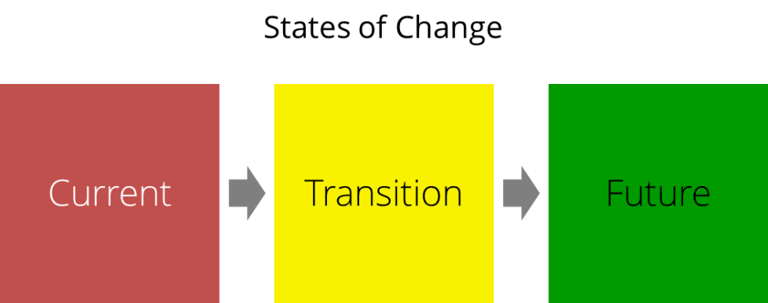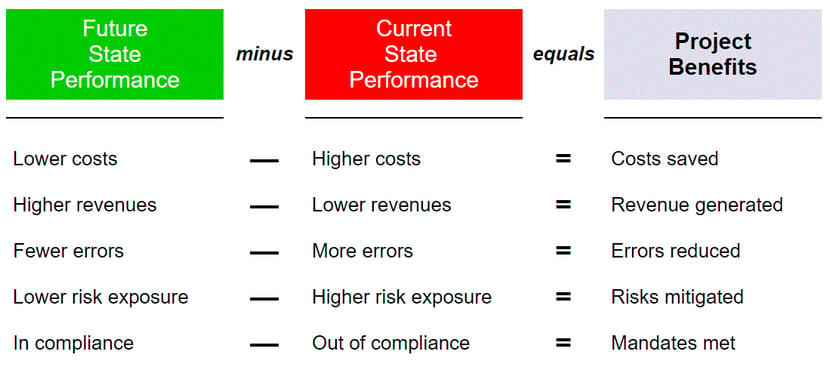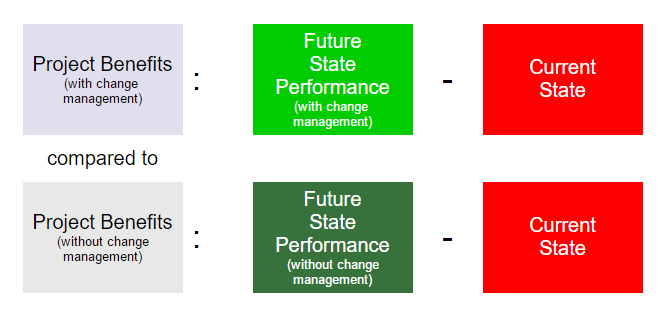How to Conceptualize the ROI of Change Management

3 Mins
Updated: August 12, 2022
Published: July 3, 2015

Explaining the ROI of change management requires understanding how it relates to the three states of change. In this blog, we leverage a straightforward states of change model—current state, transition state, future state—to help you explain project ROI and show how the ROI of change management is found in each of the three states. It also sets the stage for building a better understanding, model and calculator for CMROI (Change Management Return on Investment).
Calculating ROI
Return on Investment (ROI) is basically the incremental improvement divided by the cost to realize that improvement:

This approach has been used to calculate project ROI in many business cases. The ROI of change management has been a challenge to evaluate.
Basis of Change - The Three States
Prosci uses a simple three states of change model—current, transition, future—to describe change. Whether a process optimization effort, electronic medical records installation, software upgrade, acquisition, relocation or regulatory efforts—change is a movement from how things are today (the current state) to a new way of operating (the future state) through a change process (the transition state).

This model permeates the change management literature and can be found in works like:
- Arnold Van Gennep (1900s) - studying cultural rites of passage
- Kurt Lewin (1940s) - using the language unfreezing, moving, refreezing
- William Bridges (1970s) - using the language ending, neutral, new beginning
While it is true that organizations today are more in a state of "slush" than ever refreezing, and numerous changes continue in waves, each change initiative or project can be described by what we did (current state), what we will do (future state) and how we will make the change (transition state).
Where Does Initiative or Project ROI Come From?
Using the three states of change, we can see where the ROI for the change itself comes from (not for change management yet). The improvement or benefits of the project come from the difference between the future state performance and the current state performance—the delta—along the dimensions the project aimed to improve. The examples below show how the difference between future and current performance creates the project benefits:

The ROI of the project or initiative comes from that difference in performance. This delta is based on achievement of expected results and outcomes and benefit realization. It is delivering on the reasons we embarked on the change in the first place.
Where Can We Find the ROI of Change Management in the Three Phases?
Change management is different—because we don't have a future state and current state to provide a delta. Instead, change management is applied to a particular change to improve the efficiency in moving through the transition state and the effectiveness in the future state. Effective change management increases the project benefits realized by a change. It increases the delta between the future state and the current state of a project.
The delta for change management then does not come from subtracting the current state performance from the future state performance, like the delta of a project. The ROI, or delta, for change management instead is the difference between:
- Project benefits IF we can improve adoption and usage with change management, and
- Project benefits IF we do not apply change management.
A particular project is going to occur. We can run the project with change management or without change management. The ROI of change management is the difference in project benefits realized if we actively drive employee adoption and usage or those if we do not.

Change management directly supports benefit realization and project ROI by increasing the project benefits captured through a more efficient transition state and more effective future state. By applying change management we can:
Improve the transition state which creates more project benefits:
- Increase the speed of employee adoption
- Make sure employees have the answers they need
- Ensure training occurs at the right time with the right context
- Show leadership and organizational commitment to change
- Reduce the number of barrier or obstacles experienced
Improve the future state which creates more project benefits:
- Increase ultimate utilization of the change by employee
- Reduce the number of employees who opt out
- Drive employee proficiency when they have adopted the change
- Encourage sustained results for the initiative
- Reinforce desired changes by employees
Get a Seat at the Table
Essentially, we have a change that we know is going to happen. If we apply change management, we increase the project benefits the change generates by more efficiently moving through the transition state and more effectively arriving in the future state. The ROI of change management is the improvement in project ROI that comes from focusing on and driving employee adoption and usage. As a change management practitioner, you can begin describing the ROI of change management within the context of project ROI to build buy-in and commitment, so you gain a seat at the table.


